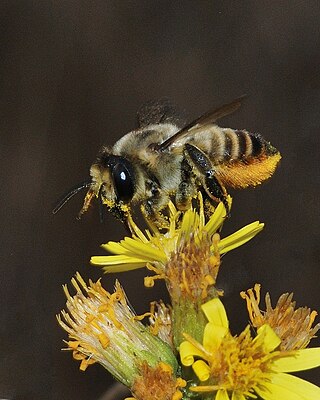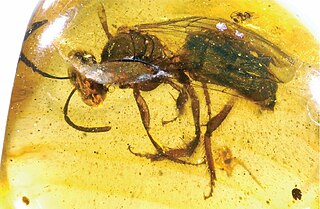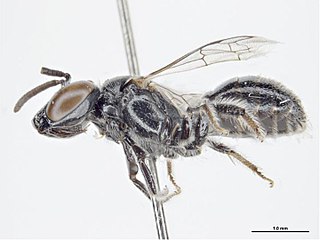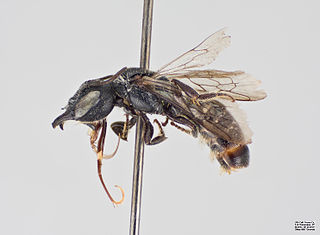
Apidae is the largest family within the superfamily Apoidea, containing at least 5700 species of bees. The family includes some of the most commonly seen bees, including bumblebees and honey bees, but also includes stingless bees, carpenter bees, orchid bees, cuckoo bees, and a number of other less widely known groups. Many are valuable pollinators in natural habitats and for agricultural crops.

Carpenter bees are species in the genus Xylocopa of the subfamily Xylocopinae. The genus includes some 500 bees in 31 subgenera. The common name "carpenter bee" derives from their nesting behavior; nearly all species burrow into hard plant material such as dead wood or bamboo. The main exceptions are species in the subgenus Proxylocopa, which dig nesting tunnels in suitable soil.

Halictidae is the second-largest family of bees with nearly 4,500 species. They are commonly called sweat bees, as they are often attracted to perspiration. Halictid species are an extremely diverse group that can vary greatly in appearance. These bees occur all over the world and are found on every continent except Antarctica. Usually dark-colored and often metallic, halictids are found in various sizes, colors and patterns. Several species are all or partly green and a few are red, purple, or blue. A number of them have yellow markings, especially the males, which commonly have yellow faces, a pattern widespread among the various families of bees. The family is one of many with short tongues and is best distinguished by the arcuate basal vein found on the wing. Females in this family tend to be larger than the males. They are the group for which the term 'eusocial' was first coined by entomologist, Suzanne Batra.

The genus Megachile is a cosmopolitan group of solitary bees, often called leafcutter bees or leafcutting bees; it also includes the called resin bees and mortar bees. While other genera within the family Megachilidae may chew leaves or petals into fragments to build their nests, certain species within Megachile neatly cut pieces of leaves or petals, hence their common name. This is one of the largest genera of bees, with more than 1500 species in over 50 subgenera. The alfalfa leafcutter bee is managed on a commercial scale for crop pollination, and has been introduced by humans to various regions around the world.

The genus Halictus is a large assemblage of bee species in the family Halictidae. The genus is divided into 15 subgenera, some of dubious monophyly, containing over 200 species, primarily in the Northern Hemisphere. Most species are black or dark brown, sometimes metallic greenish-tinted, with apical whitish abdominal bands on the terga.

The bee subfamily Panurginae is a diverse lineage of 33 genera in 7 tribes. They are particularly diverse in the New World, though scarce in the tropics, and in the Old World they can be found primarily in the Palaearctic and Africa, but absent from Australia and tropical Asia. They tend to be associated with xeric or sandy habitats.

The cosmopolitan bee genus Ceratina, often referred to as small carpenter bees, is the sole lineage of the tribe Ceratinini, and is not closely related to the more familiar carpenter bees. The genus presently contains over 300 species in 23 subgenera. They make nests in dead wood, stems, or pith, and while many are solitary, a number are subsocial, with mothers caring for their larvae, and in a few cases where multiple females are found in a single nest, daughters or sisters may form very small, weakly eusocial colonies. One species is unique for having both social and asocial populations, Ceratina australensis, which exhibits all of the pre-adaptations for successful group living. This species is socially polymorphic with both solitary and social nests collected in sympatry. Social colonies in that species consist of two foundresses, one contributing both foraging and reproductive effort and the second which remains at the nest as a passive guard. Cooperative nesting provides no overt reproductive benefits over solitary nesting in this population, although brood survival tends to be greater in social colonies. Maternal longevity, subsociality and bivoltine nesting phenology in this species favour colony formation, while dispersal habits and offspring longevity may inhibit more frequent social nesting in this and other ceratinines.

Ferdinand Ferdinandovich Morawitz was a Russian entomologist.

Oligochlora is an extinct genus of sweat bee in the Halictidae subfamily Halictinae. The genus currently contains six species, all of which are known from the early Miocene Burdigalian stage Dominican amber deposits on the island of Hispaniola.
Augochlora leptoloba is a species of sweat bee in the genus Augochlora and the extinct monotypic subgenus Electraugochlora.

Dasypoda is a genus of bees in the family Melittidae.

Ancylaini is a tribe of apid bees. The name was fixed by an ICZN opinion to differentiate it from the Ancylini tribe of fresh-water molluscs.

Tetragonula is a genus of stingless bees. In 1961, Brazilian bee expert J.S. Moure first proposed the genus name Tetragonula to improve the classification system by dividing the large genus Trigona stingless bees into 9 smaller groups. About 30 stingless bee species formerly placed in the genus Trigona are now placed in the genus Tetragonula. These bees are found in Oceania, in countries such as Australia, Indonesia, New Guinea, Malaysia, Thailand, the Philippines, India, Sri Lanka, and the Solomon Islands. The most recent tabulation of species listed 31 species.

Braunsapis is a genus of bees in the tribe Allodapini. It is the largest genus of the tribe and is known for its array of social behaviors. The genus is distributed in Africa, Asia, and Australasia.

Sphecodes is a genus of cuckoo bees from the family Halictidae, the majority of which are black and red in colour and are colloquially known as blood bees. Sphecodes bees are kleptoparasitic on other bees, especially bees in the genera Lasioglossum, Halictus and Andrena. The adults consume nectar, but because they use other bees' provisions to feed their offspring they do not collect pollen.

Melecta is a genus of cuckoo bees in the family Apidae. There are at least 50 described species in Melecta.

Panurginus is a genus of bees in the family Andrenidae. There are more than 50 described species in Panurginus.

Protosmia is a genus of subgenus Chelostomopsis in the family Megachilidae. There are more than 30 described species in Protosmia.

Ammobates is a genus of cuckoo bees belonging to the family Apidae.


















